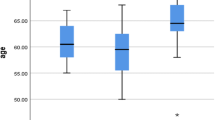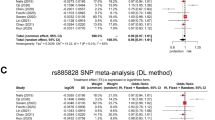Abstract
Besides clinical and imaging techniques, there is a lack of molecular makers for the diagnosis of Parkinson’s disease (PD). There is an immense need to develop biomarkers associated with the phenotypes which may be valuable for individualized treatment. Single-nucleotide polymorphisms (PARK2: Ser167Asn (G>A) and Val380Leu (G>C); PARK7: IVS4 + 46G>A and IVS4 + 30T>G) in PD-related genes were examined to elucidate its relationship with concentration of serum elements and clinical symptoms of PD. A total of 214 PD patients and 213 controls from Indian population were genotyped using PCR and DNA sequencing methods. The serum element concentrations were detected and clinical symptoms were determined based on UPDRS scale and recorded at the time of sample collection. The IVS4 + 30T>G, Ser167Asn (G>A) and Val380Leu (G>C) polymorphisms appeared to alter element concentrations in PD. The patients with Ser167Asn polymorphism showed significant association with copper, iron and zinc that reinforces the role of A allele as a factor for change in the concentrations of elements, than those patients with G allele. In particular, patients with A allele of Ser167Asn have risk of having high serum iron concentration (OR 11.55, 95% CI 5.59–23.85), which are associated with dementia and postural imbalance. Similar results were observed for Val380Leu (G>C) and IVS4 + 30T>G polymorphisms which suggest their role in element concentration and neurological symptoms. Overall, our study demonstrates the influence of polymorphisms of PD genes on element concentrations and clinical symptoms. Results of this study may be taken into account when considering the contributing factors for PD symptoms.

Similar content being viewed by others
References
Ahmed SSSJ, Santosh W (2010) Metallomic profiling and linkage map analysis of early Parkinson’s disease: a new insight to aluminum marker for the possible diagnosis. PLoS ONE 5:e11252
Alexander GE (2004) Biology of Parkinson’s disease: pathogenesis and pathophysiology of a multisystem neurodegenerative disorder. Dialogues Clin Neurosci 6:259–280
Bertoli-Avella AM, Oostra BA, Heutink P (2004) Chasing genes in Alzheimer’s and Parkinson’s disease. Hum Genet 114:413–438
Björkblom B, Adilbayeva A et al (2013) Parkinson disease protein DJ-1 binds metals and protects against metal-induced cytotoxicity. J Biol Chem 2 288(31):22809–22820
Bocca B, Forte G, Petrucci F, Senofonte O et al (2005) Development of methods for the quantification of essential and toxic elements in human biomonitoring. Ann Ist Super Sanita 41:165–170
Bocca B, Alimonti A, Senofonte O, Pino A et al (2006) Metal changes in CSF and peripheral compartments of parkinsonian patients. J Neurol Sci 248:23–30
Bonifati V, Rizzu P, van Baren MJ et al (2003) Mutations in the DJ-1 gene associated with autosomal recessive early-onset parkinsonism. Science 299:256–259
Caudle WM, Guillot TS (2012) Industrial toxicants and Parkinson’s disease. Neurotoxicology 33:178–188
Chakraborty S, Chen P et al (2015) Loss of pdr-1/parkin influences Mn homeostasis through altered ferroportin expression in C. elegans. Metallomics 7(5):847–856
Cordato DJ, Chan DK (2004) Genetics and Parkinson’s disease. J Clin Neurosci 11:119–123
Forte G, Bocca B, Senofonte O, Petrucci F et al (2004) Trace and major elements in whole blood, serum, cerebrospinal fluid and urine of patients with Parkinson’s disease. J Neural Transm 111:1031–1040
Forte G, Alimonti A, Pino A, Stanzione P et al (2005) Metals and oxidative stress in patients with Parkinson’s disease. Ann Ist Super Sanita 41:189–195
Ikawa M, Okazawa H, Kudo T, Kuriyama M et al (2011) Evaluation of striatal oxidative stress in patients with Parkinson’s disease using [62Cu] ATSM PET. Nucl Med Biol 38:945–951
Jenner P, Olanow W (2006) The pathogenesis of cell death in Parkinson’s disease. Neurology 66:S24–S36
Koç ER, Ilhan A, AytüRk Z, Acar B et al (2015) A comparison of hair and serum trace elements in patients with Alzheimer disease and healthy participants. Turkish J Med Sci 45:1034–1039
Lavanya PD, Reddy BS, Rao DA et al (2014) Trace elemental analysis of blood serum samples of patients afflicted with Parkinson’s disease. Int J Bioassays 3:1858–1865
Meamar R, Chitsaz A, Aghaye-Ghazvini MR (2015) Trace blood elements and severity of Parkinson’s disease. J Res Med Sci 32:1870–1878
Medeiros MS, Schumacher-Schuh A, Cardoso AM et al (2016) Iron and oxidative stress in Parkinson’s disease: an observational study of injury biomarkers. PLoS ONE 11:e0146129
Moore DJ, Zhang L, Troncoso J, Lee MK et al (2005) Association of DJ-1 and parkin mediated by pathogenic DJ-1 mutations and oxidative stress. Hum Mol Genet 14:71–84
Morett E, Bork P (1999) A novel transactivation domain in Parkin. Trends Biochem Sci 24:229–331
Muralidhar LH et al (2004) Serum trace element levels and the complexity of inter-element relations in patients with Parkinson’s disease. J Trace Elem Med Biol 18:163–171
Nikam S, Nikam P, Ahaley SK, Sontakke AV (2009) Oxidative stress in Parkinson’s disease. Indian J Clin Biochem 24:98–101
Ogunrin AO, Komolafe MA, Sanya EO et al (2013) Trace metals in patients with Parkinson’s disease: a multi-centre case–control study of Nigerian patients. J Neurol 1:31–38
Pekny M, Pekna M, Messing A, Steinhäuser C et al (2016) Astrocytes: a central element in neurological diseases. Acta Neuropathol 131(3):323–345
Sanyal J, Jana A, Ghosh E, Banerjee TK et al (2015) Evaluation of PARKIN gene variants in West Bengal Parkinson’s disease patients. J Hum Genet 60:485–492
Sanyal J, Ahmed SSSJ, Tony Ng HK, Naiya T (2016) Metallomic biomarkers in cerebrospinal fluid and serum in patients with Parkinson’s disease in Indian population. Sci Rep 6:35097
Sensi SL, Granzotto A, Siotto M, Squitti R (2018) Copper and zinc dysregulation in Alzheimer’s disease. Trends Pharmacol Sci 39(12):1049–1063
Zhang Y, Wang ZZ, Sun HM (2012) Lack of association between p.Ser167Asn variant of Parkin and Parkinson’s disease, a meta-analysis of 15 studies involving 2280 cases and 2459 controls. Am J Med Genet 15:38–47
Zhao H-W, Lin J, Wang X-B et al (2013) Assessing plasma levels of selenium, copper, iron and zinc in patients of Parkinson’s disease. PLoS ONE 8:e83060
Acknowledgements
This research work is supported by the Grant (Project Sanction No: 4-FP/6/PMI (Considered under National project “Human Origins, Genome and People of India-DNA Polymorphism”)) from Anthropological Survey of India, Ministry of Culture, Government of India and ICMR EMS Grant to VRR (Letter No. 74/1/2016-Pers.EMS). We are thankful to the team of doctors, the PD patients and control subjects for voluntarily taking part in this research work and donating their blood samples. We also thank Mitali Maity (nurse in NNC) for helping in the collection of blood samples from the OPD of NNC. JS is thankful to CSIR for providing the Research Associate Fellowship (CSIR RA Code ID: 9/45(1283)/2013 EMR-I).
Funding
This research work is supported by the Grant (Project Sanction No: 4-FP/6/PMI (Considered under National project “Human Origins, Genome and People of India-DNA Polymorphism”)) from Anthropological Survey of India, Ministry of Culture, Government of India and ICMR EMS grant to VRR (Letter No 74/1/2016-Pers.EMS).
Author information
Authors and Affiliations
Contributions
JS designed the research work with VRR and SSSJA, performed the experiments and wrote the manuscript. SSSJA planned the research work, statistically analysed the data and wrote the draft of the manuscript. AA was involved in the statistical analysis. R provided critical suggestion for the genetic analysis. RM provided critical suggestion while analysing the data. TKB and GG are the clinical collaborators involved in identifying the PD patients and control. VRR organized the research project, mentor, who received the grant for the project on PD in India.
Corresponding authors
Ethics declarations
Conflict of interest
The authors declare no conflict of interest.
Ethical Approval
All procedures performed in studies involving human participants were in accordance with the ethical standards of the institutional committee and with the 1964 Helsinki Declaration and its later amendments or comparable ethical standards.
Additional information
Publisher's Note
Springer Nature remains neutral with regard to jurisdictional claims in published maps and institutional affiliations.
Electronic supplementary material
Below is the link to the electronic supplementary material.
Rights and permissions
About this article
Cite this article
Sanyal, J., Anirudhan, A., Banerjee, T.K. et al. PARK2 and PARK7 Gene Polymorphisms as Risk Factors Associated with Serum Element Concentrations and Clinical Symptoms of Parkinson’s Disease. Cell Mol Neurobiol 40, 357–367 (2020). https://doi.org/10.1007/s10571-019-00734-z
Received:
Accepted:
Published:
Issue Date:
DOI: https://doi.org/10.1007/s10571-019-00734-z




